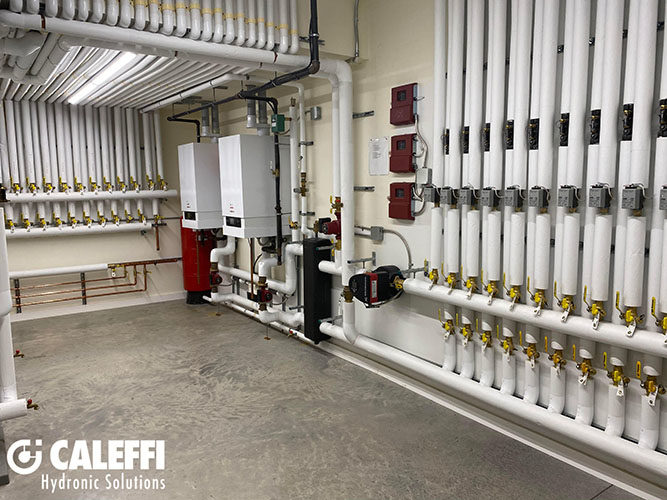Zoning and Balancing Residential Hydronic Systems
Making people comfortable while spending less.

In residential hydronic systems, zoning and balancing tend to blur together. In the days of on/off boilers running high temperatures, zoning made sense to control ambient temperatures around the home. Those boiler aquastats were set to 180 degrees because we needed to ensure the system would keep up on those design days that happened a few times a year.
However, when it wasn’t a design day, we didn’t need all that heat and zoning made for the easiest way to compensate and somewhat control the comfort in a home.
From the perspective of North American homeowners, it makes sense that if they want to control temperatures in their homes, they need more thermostats. This is what led us into the era of micro-zoning — a time when every room in the home had its own thermostat, boilers short-cycled, buffer tank sales boomed and controls got wildly complicated.
The downside to the overuse of zoning, especially with high-temp boilers, is that it does not provide optimal comfort for the occupants. The on/off nature of these systems tends to cause temperature swings and leads to less efficient systems due to short-cycling of equipment.
In a perfect world, your heat source would run continuously throughout the heating season to provide only enough to make up for the heat loss of the space and no more. Modulating, high-efficiency boilers equipped with outdoor/indoor reset controls brought us a new level of comfort and efficiency, but even they can only do so much!
As we see energy prices continue to rise, dialing in our heating systems will be paramount. You and your customers should be making every effort to reduce supply temperatures and eliminate short-cycling. We’re already seeing this in other markets around the world.
Comfort and Efficiency are Possible
In the UK, where energy costs are substantially higher, techs pride themselves on setting up their systems to operate on the lowest supply water temperatures and achieve incredibly long average run times. In most cases, they keep the boiler or heat source running for hours at a time, modulating and maintaining. This is all while maintaining happy, comfortable customers. I’d have to think those guys and gals must be on to something! Comfort and efficiency, is it possible?
The interesting part about what they’re doing in the UK on the average residential application is what they’re not doing: zoning. What they’re doing to achieve this in their hydronic systems is not magic; it’s balancing.
I think back to a time when I was finishing and starting up a new construction house. The hydronic system had five zone valves in the mechanical room, each controlling a manifold hiding somewhere in the home. After some time living in the home, there was one spot that wasn’t quite as comfortable as the owners had hoped.
Per the owner’s request, we took a three-loop manifold and zoned it (after already being in its own zone) with manifold actuators. This meant that a single in-floor loop could call for heat by itself. Luckily, the system was designed with a buffer tank.
I think back to that job and wonder if we could’ve made it work without actuators on the manifold or an extra thermostat. I’ll bet that if we adjusted flow rates in the manifold, we could’ve made the area more comfortable, the system more efficient, and prevented the controls from being any more complex and expensive than they already were.
More Balancing, Less Zoning
This is where we need to learn to rely less on zoning and more on balancing. Don’t get me wrong, zoning will still be a necessity in the much larger homes that we have here, but instead of every room or loop being a zone, we’ll have to be a bit more strategic. Maybe we’ll zone based on southern or east/west exposure? Maybe we’ll zone based on the frequency of occupants or living space vs. sleeping space? In any case, these larger zones will allow for longer system run times and more efficient operation of heating systems.
However, with larger zones comes the possibility of uneven temperatures from room to room, and we can’t have that! This is where balancing will save the day. Balancing the flow rates to the heat emitters in these spaces can help you achieve great comfort for your customers. Knowing the required flow rates and supply temperatures for these spaces will require a great understanding of the heat loss of the space along with the heat output characteristics of the heat emitter.
So, when it comes to balancing residential hydronic systems, I usually only see it done on radiant floor jobs with flow meters built into the manifolds. It’s easy, and the contractors usually have a schedule or drawing from the system designer or radiant tubing manufacturer telling them exactly what the supply temperatures and flow rates should be. What about balancing other types of heat emitters?
When it comes to balancing fan coils, radiators, baseboard loops and other heat emitters, it’s often overlooked. This is because balancing is well-known to be one of the most difficult and time-consuming tasks for any heating system. Balancing valves, as simple as they are, are not commonplace in residential hydronics. Not only does it require special tooling to read differential pressure across the valve, but the job often takes a special person as well.
Luckily for everyone, things have changed in the world of balancing. Like the flow meters on radiant manifolds, there are dedicated balancing valves that are just as easy. With a flow meter built right in, anybody can do the job! Set the flow, change it as needed and dial in that system.
What we’re all trying to accomplish in the end is to build cost-effective, efficient and comfortable hydronic systems. Without comfort, what good is a heating system? If you can’t provide it, people will do all kinds of things to achieve it.
Think about all the homes you’ve been in where you’ve seen space heaters or the apartment buildings you’ve driven by in the dead of winter with windows open. All these attempts at comfort come at a price. With proper application of zoning and balancing, you, too, can give your customers the comfort and efficiency they seek.





